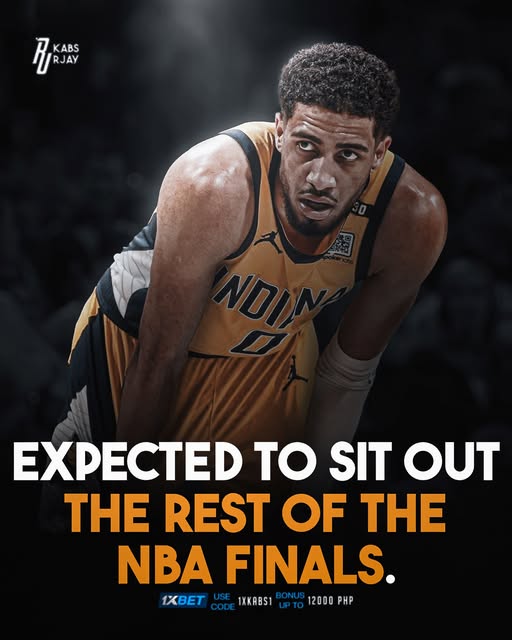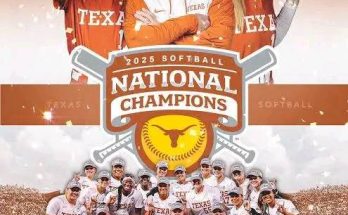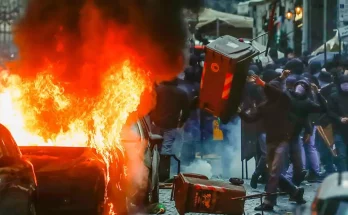Tyrese Haliburton’s season-changing nightmare began in the first quarter of Game 5 of the NBA Finals. In a moment that sent shockwaves through Indiana and across league circles, the Pacers’ 25-year-old floor general went down clutching his right calf. He exited the court, leaning heavily on trainers, before being rushed to the locker room. Yet despite a visible struggle and clear discomfort, Haliburton returned in the second quarter with his calf heavily taped—an iron-willed display of resolve that belied just how serious his condition truly was
From that moment, the tone of Game 5 shifted. Haliburton’s sharpness evaporated, his hallmark court vision blunted, and scoring prowess all but vanished. By night’s end, he had tallied just four points—all from free throws—alongside seven rebounds and six assists across 34 minutes. Yet perhaps most startling was his 0-for-6 performance from the field, as he became the first All‑NBA player since 1958 to emerge from a Finals game with zero field goals .
The statistical dissection doesn’t lie. In a postseason where he had been averaging 17.9 points, 9.1 assists, and 5.8 rebounds over 21 games, the off-night stood out as a glaring anomaly And while those numbers underscore just how elite his overall playoff run had been, they also serve as a far starker illustration of how dramatically his presence—or lack thereof—impacts this series. As Oklahoma City throttled Indiana 120-109 and wrested control of the series 3-2, the Pacers’ championship hopes grew dimmer
The injury itself has been widely reported as a right calf strain, sustained in that pivotal opening quarter. Though Haliburton soldiered through the pain, the MRI scheduled in the days following would likely be the first clear indicator of the injury’s true severity . Indiana’s head coach Rick Carlisle admitted that Haliburton was “not 100 percent” but stressed that he expected him back in time for Game 6
The gravity of the situation intensified with reports emerging that Haliburton could be sidelined for the remainder of the Finals. Posts on social media outlets claimed a stern prognosis: “Haliburton will likely miss the remainder of the NBA Finals with a right calf injury.” . While those reports are yet to be officially confirmed, the severity of his limited performance and physical distress lend credence to the prognosis. The question looming now is whether the MRI will validate the worst fears.
For Indiana, the implications are monumental. Haliburton is not just their point guard—he’s the heart and soul of this iteration of the Pacers. A transformative talent, the cerebral playmaker who commands offenses, manipulates defenses, and has delivered buzzer-beating heroics throughout this postseason. His legendary shot in Game 1 that flipped a 1–0 deficit into a historic win is already part of Finals lore , but Game 5 revealed a glaring truth: without him at full strength, this Pacers team looks ordinary.
The impact on Game 6 is already being felt. T.J. McConnell, who poured in 18 bench points in Game 5, is all but certain to be thrust into a starting role. The backcourt chemistry shifts, offensive upholstery frays, and the shot creation responsibility falls heavily on Pascal Siakam and Andrew Nembhard. Pascal tried valiantly in Game 5, pouring in 28 points, but his 6 turnovers in that outing underscored the intangible value and stabilizing effect a healthy Haliburton brings .
But what happens if Game 6 comes and Haliburton doesn’t? Or if he suits up, failing the ‘can walk’ test, but clearly hampered? The ripple effect is immediate. Defenses will pack the paint, daring Indiana to hit the corners, sap driving thrusts, and force others to step up. Without Haliburton’s gravity, Oklahoma City will feast on mismatches, aided by a Thunder attack that exploded for 14 threes and 40 clutch points from Jalen Williams in Game 5 . A Pacers bench unit that nearly erased an 18-point deficit in the third will now become the fulcrum—not the supplement.
Yet Indiana didn’t get here on hope alone—they earned it. This year’s Pacers overcame slow starts and nagging injuries to clinch the 4th seed, reach 50 wins, and dispatch Milwaukee, Cleveland, and New York en route to their Finals berth . Tyrese was the emotional and tactical fulcrum of that run—this postseason has seen him spray frappes from downtown, assert his craft savvy, and be a defensive backbone. He became a two-time All-Star, All-NBA honoree, and an Olympic gold medalist in Paris. Now, that run dangles renewed stakes and heartbreak.
The fallout from halting Haliburton’s momentum might echo far beyond this home game. Should Game 6 slip away, the series would end in Game 7 back in OKC—where the Thunder have been nearly untouchable. If the MRI confirms a moderate to severe strain, the Pacers face an agonizing wait. Even with top treatment, calf strains are notorious. The timeline to recovery can span multiple weeks—and the pressure for a return, real or perceived, could risk plateauing his long-term health and perhaps his future seasons.
Awaiting answers, the Pacers and their fans cling to a few thin threads. Carlisle has projected belief in Haliburton’s resilience, saying he did “make a lot of things happen in the second half” despite the injury . Meanwhile, Haliburton himself has echoed steely determination: “If I can walk, then I want to play,” he told reporters. “It’s the Finals… I want to be out there to compete”
Supporters have rallied behind him. His girlfriend, Jade Jones, posted images of neighborhood placards and banners proclaiming “We Back You, Tyrese,” perhaps emblematic of the communal hope and emotional solidarity that Indiana Pacer faithful bring to this moment It’s a powerful symbol in a sport where mental resolve can shift the faintest margins.
On the national stage, the conversation has turned to respect and outrage. ESPN’s Stephen A. Smith drew fire for claiming he was “glad he’s injured,” suggesting the injury was a preferable explanation for Haliburton’s cold show compared to a lapse in effort Critics decried it as opportunistic, while others contended it underlined just how essential Haliburton is—and what a vacuum he leaves if limited or absent.
The result of the MRI, expected in the next 24 hours, could reframe the entire Finals. A mild strain offering a week of rest and aggressive rehabilitation could allow him to return for Game 6—though repeatedly clarifying “if I can walk” may suggest Houston’s cautious optimism. A more serious grade–2 or grade–3 tear would shut the door for him, potentially sidelining him not only for the rest of the series but for several weeks. For a player whose game revolves on mobility, vertical pop, change-of-pace drives, and lateral quickness, a calf that isn’t fully healed is a liability—and playing injured even marginally could lead to cascading damage. For the Pacers, it might mean waving goodbye to a once-in-a-lifetime Finals run.
The Pacers’ response will be as crucial as the diagnosis. Historically, they’ve shown defensive cohesion and collective grit, but none of that compensates fully for the intelligence, timing, and clutch shot-making Haliburton supplies. Jalen Williams, Shai Gilgeous-Alexander, and the Thunder will foreseeably exploit any void he leaves. The rash of turnovers in Game 5—where 23 led to 32 Thunder points—illustrated the thin line Indiana is walking becomes a crucible. Win, and the Pacers force a final return to OKC—but win without your star? It’s a statement of team belief. Lose, and the absence will be an undeniable turning point—a reminder of both the fragility and the valor inherent in peak performance.
Yet even if he returns, watch closely for changes. A shortened minute load, defensive bracketing designed to protect him, or increased sit-times would signal delicacy. The Pacers may need to rebuild their spacing, with McConnell and Nesmith asked to carry heavier offensive loads, and limit Haliburton’s traditional off-ball creation. Opposing coaches will zone in on him. And with mental fatigue compounding physical tapering, orchestrating his health and damage control becomes as much a coaching strategy as any X’s-O’s playbook.
Haliburton’s path forward—MRI in hand, recovery plan underway—will shape not just a game, or a series, but potentially his legacy. Already a Finals highlight reel contender, Olympic champion, All-NBA talent, enduring clutch performer, this is the inflection point: will he rise from injury and lead a valiant closeout at home, or be forced to watch the postseason slip by from the bench or the sidelines?
There is no glossing over the predicament. Indiana’s hope teeters on one leg—both their guard’s and their depth. Oklahoma City, armed by 40-point explosions and dogged perimeter schemes, will press the envelope. The entire basketball world watches, waiting for the MRI verdict, the rehab progress, Haliburton’s own 6‑foot‑5 silhouette taking to the floor in Game 6 or sitting, forced out by medical need.
From that first limp in Game 5 onward, the Finals shifted from contest to crisis. If Haliburton’s brace returns, the series stays balanced. If not, it becomes yet another story of unfinished promise ending in narrow heartbreak. For now, the Pacers and their star walk a tightrope—each step physical, every heartbeat emotional, and every outcome irreversible.
None of it was supposed to happen this way. Haliburton’s story was of ascension, not attrition. His climb through the league, Olympian prowess, playoff heroism—all seemed to culminate here, on the sport’s ultimate stage. Now one twisted calf tells a different story. A journey that once appeared unstoppable now balances—on hope, grit, and the frailty of flesh—on the edge of a trapdoor.
The Pacers’ destiny, still unwritten, rests not only on their star’s mobility, but on a hospital scan and an ankle’s recovery. And whether his name flashes or fades on the Game 6 injury list, one truth stands: this moment defines everything. For Haliburton. For Indiana. And for a Finals series now teetering on one man’s ability to walk.



